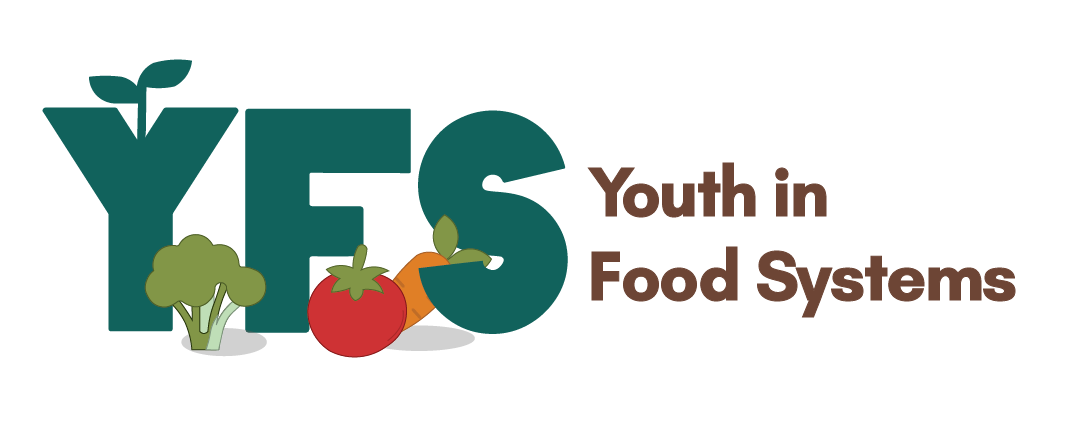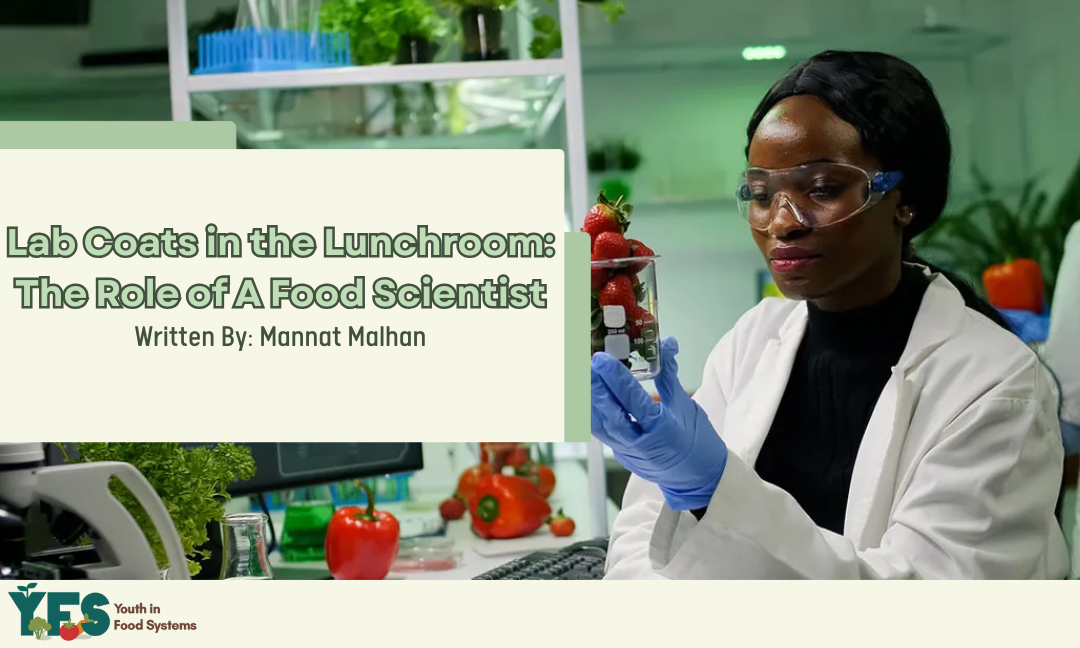Written by: Mannat Malhan
Edited by: Eleanor Jeavons
Designed by: Rashiqa Ali
Published by: Rayna Almas
There’s a whole team of people making sure your chips stay crispy and your ice cream doesn’t melt too fast. Spoiler: They’re not wearing aprons. They’re wearing lab coats. With a growing population and climate change affecting what we eat, the world needs food scientists more than ever. But what do they actually do?
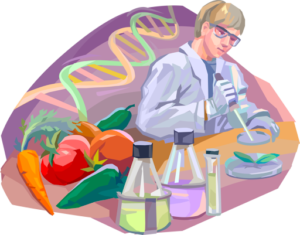 A food scientist is someone who makes food last as long as possible, while still being nutritious and tasting delicious. In food science, the process of making food involves creating new recipes, refining old ones, maintaining high standards of food safety, analyzing nutritional content, and understanding how people perceive food from their perspective.
A food scientist is someone who makes food last as long as possible, while still being nutritious and tasting delicious. In food science, the process of making food involves creating new recipes, refining old ones, maintaining high standards of food safety, analyzing nutritional content, and understanding how people perceive food from their perspective.
There is a lot of complicated science required to make these observations, and we can break down these areas into four sections:
1) Research and Development: This includes the process of making new food products, from their start to their market launch. It also involves improving existing products to refine their taste, nutritional value, or shelf life.
2) Nutrition Analysis: This area involves assessing the nutrients of food, macronutrients (proteins, carbohydrates, fats), and micronutrients (vitamins and minerals). Through this, food scientists can understand the impact of food on the human body.
3) Studying the Make-up of Food: Following the last area, this section analyzes the composition of foods on a molecular level. It studies the biological components (like microorganisms), chemical compounds, and physical properties of food to understand it.
4) Sensory Analysis: Understanding food involves how we perceive food through our senses as consumers. Food scientists use controlled tests to assess the texture, aroma, taste, and appearance of products. Using this data, they can get valuable feedback for product development and quality control.
 Due to the vast range of their job, food scientists can work in a variety of places, including processing plants, laboratories, and offices. They may oversee processing techniques, monitor production lines, conduct quality checks, and analyze data on the food being produced. As mentioned in the four sections, food scientists are constantly involved in research, product development, quality control, and ensuring food safety throughout various stages of the food production process.
Due to the vast range of their job, food scientists can work in a variety of places, including processing plants, laboratories, and offices. They may oversee processing techniques, monitor production lines, conduct quality checks, and analyze data on the food being produced. As mentioned in the four sections, food scientists are constantly involved in research, product development, quality control, and ensuring food safety throughout various stages of the food production process.
Now that we understand the definition of food science, let’s take a look at its importance. The study of food helps us understand the plants and animals we eat and how to improve current food systems to make them more sustainable. For one, improving food safety and quality will always be a key part of sustainability. Food scientists solve issues like reducing foodborne illnesses and creating environmentally safe packaging.

Along with that, we can understand the nutrients the human body needs and how to enhance foods to meet those needs. Improving the nutritional value of foods that people already like can raise the overall health of a population. This can be especially useful in places where there is a growing need for food. Food accessibility remains an issue in many parts of the world. With the help of food scientists, we can create new food production pipelines to create affordable, nutritional food options in deprived areas.
Right now, the world has many useful food innovations to show off the impressive work of food scientists. One great example includes plant-based meat. Plant-based meat is made to mimic the texture, appearance, and taste of animal meat. Using food science, scientists have extracted, isolated, and texturized plant proteins to create a fibrous structure. Afterwards, colour and flavour are added using natural flavourings, such as heme from soy legemoglobin, to simulate the feel of meat.
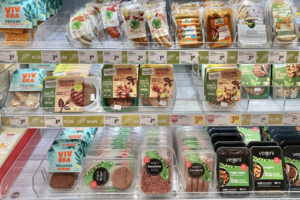
Not only has food science helped make new things, it has also improved existing items, like baby formula. Food scientists have significantly changed baby formula over time by adding ingredients that mimic human milk’s composition and offering health benefits. These improvements involve fortifying formulas with iron, adding nucleotides (compounds naturally found in breast milk), and refining protein blends. Furthermore, studies in understanding the infant gut microbiome have led to the addition of prebiotics, probiotics, and complex sugars acting as prebiotics, like HMOs (human milk oligosaccharides), to help with immunity.
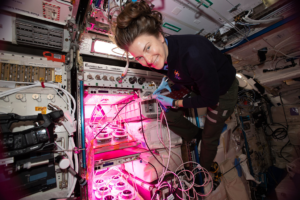 Not only do food scientists help shape nearly everything in your pantry, but they also help shape the food up in space for astronauts. A fun fact about astronaut food and food scientists is that they helped develop liquid salt and pepper because traditional shakers wouldn’t work in microgravity. The solid spices would just float away and invade the technology in the spacecraft. Instead, astronauts get liquid versions of these seasonings to ensure that they can still enjoy tasty food without creating more issues in their work. A NASA food scientist has talked about the 200 food and beverage options for astronauts to choose from, all thanks to the hard work of food science.
Not only do food scientists help shape nearly everything in your pantry, but they also help shape the food up in space for astronauts. A fun fact about astronaut food and food scientists is that they helped develop liquid salt and pepper because traditional shakers wouldn’t work in microgravity. The solid spices would just float away and invade the technology in the spacecraft. Instead, astronauts get liquid versions of these seasonings to ensure that they can still enjoy tasty food without creating more issues in their work. A NASA food scientist has talked about the 200 food and beverage options for astronauts to choose from, all thanks to the hard work of food science.
“Innovation. Creating a breakthrough innovative product that disrupts the category and potentially creates a category of its own. For a food scientist, this is the most exciting and rewarding kind of project,” – FoodGrads.
So the next time you bite into a snack or crack open a soda, remember: There’s real science behind that flavour. Food scientists are the hidden heroes making sure your food is safe, tasty, and future-ready. Who knew lab coats could be this cool?
Bibliography
Works Cited
Fun Space Food Facts from a NASA Food Scientist! (n.d.). Www.youtube.com. Retrieved August 1, 2025, from https://www.youtube.com/shorts/BikGOaEESGM
U.S. Food and Drug Administration. (2023). Infant formula. FDA. https://www.fda.gov/food/resources-you-food/infant-formula
How scientists make plant-based foods taste and look more like meat. (2021). Techlifetoday.ca; NAIT.ca. https://techlifetoday.nait.ca/articles/2021/how-scientists-make-plant-based-meat
The science of plant-based meat | GFI APAC. (n.d.). Gfi-Apac.org. https://gfi-apac.org/science/the-science-of-plant-based-meat/
A Recipe for Success: Why More People are Choosing a Career in Food Science. (2023). Iit.edu. https://www.iit.edu/blog/career-in-food-science
Food Scientist: Occupations in Alberta – alis. (n.d.). Alis.alberta.ca. https://alis.alberta.ca/occinfo/occupations-in-alberta/occupation-profiles/food-scientist/
Centennial College – What does a Food Scientist do? (2024). Centennialcollege.ca. https://www.centennialcollege.ca/school-of-engineering-technology-and-applied-science-blog/2019/july/17/what-does-a-food-scientist-do/
What Does a Food Scientist Do? (And How To Become One). (n.d.). Indeed Career Guide. https://www.indeed.com/career-advice/finding-a-job/what-does-food-scientist-do
Alternate Careers | Food Science Technologist. (n.d.). https://altcareers.csmls.org/careers/food-science-technologist/
Food quality – INAF – Institute of Nutrition and Functional Foods. (2023, August 10). https://www.inaf.ulaval.ca/en/research/themes/food-quality/
Post, N. G. / or G. (2020, December 1). A Day in the Life of a Food Scientist. An Exclusive Community for the Food & Beverage Industry | FoodGrads. https://foodgrads.com/2020/12/01/a-day-in-the-life-of-a-food-scientist/
Government of Canada. (2019). Eating in space. Government of Canada. https://www.asc-csa.gc.ca/eng/astronauts/living-in-space/eating-in-space.asp
What does a food scientist do? – CareerExplorer. (n.d.). Www.careerexplorer.com. https://www.careerexplorer.com/careers/food-scientist/
What is a food scientist? A day in the life. | Cargill. (2024). Cargill.com. https://www.cargill.com/story/what-is-a-food-scientist
Food Science. (n.d.). Unity Environmental University. https://unity.edu/careers/why-is-food-science-important/
Schuman, A. (2003, February 1). A concise history of infant formula (twists and turns included). Contemporary Pediatrics. https://www.contemporarypediatrics.com/view/concise-history-infant-formula-twists-and-turns-included
Good Food Institute. (n.d.). The science of plant-based meat (2021) | GFI. Gfi.org. https://gfi.org/science/the-science-of-plant-based-meat/
